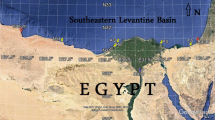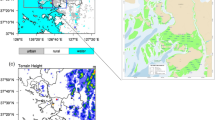Abstract
The tidal effect on a sea breeze is examined using a 4-year 30-min database of wind-speed profiles obtained from a 300-m tower at a coastal site in Boseong, South Korea, facing a bay with tidal flats. We consider sea-breeze days during the warm season from May to September of each year from 2014 to 2017. A sea-breeze day is defined as a day with both onset and cessation of a sea breeze within 24 h. Sea-breeze days are divided into four groups depending on the tidal state and ambient flow direction. The tidal effect on the sea breeze is tested at a significance level of 5% using a two-sample t-test for onshore and offshore flows. The results indicate that there is a significant difference due to tidal state in the onset time of the sea breeze only for offshore flow, showing earlier arrival for the high-tide group in the morning than the low-tide group in the morning. This could be explained by the shorter distance to the sea due to the movement of the water boundary towards the station as well as larger sea–land temperature difference during high tide. For offshore flows, the tidal effect on wind-speed profiles is examined, with results showing that the tide state influences the time at which the sea-breeze speed increases but not the daily maximum speed of the sea breeze.









Similar content being viewed by others
References
Arritt RW (1989) Numerical modeling of the offshore extent of sea breezes. QJR Meteorol Soc 115:547–570
Azorin-Molina C, Chen D (2009) A climatological study of the influence of synoptic scale flows on sea breeze evolution in the Bay of Alicante (Spain). Theor Appl Climatol 96:249–260
Crosman ET, Horel JD (2010) Sea and lake breezes: a review of numerical studies. Boundary-Layer Meteorol 137:1–29
Fischereit J, Schlünzen KH, Gierisch AMU, Grawe D, Petrik R (2016) Modelling tidal influence on sea breezes with models of different complexity. Meteorol Z 25(4):343–355
Hersbach H et al (2020) The ERA5 global reanalysis. QJR Meteorol Soc 146(730):1999–2049
Kessler RC, Eppel D, Pielke RA, McQueen J (1985) A numerical study of the effects of a large sandbar upon sea breeze development. Arch Meteorol Geophys Bioclim Ser A 34:3–26
Lee YH, Ahn KD, Lee YH (2016) Parameterization of the tidal effect for use in the noah land-surface model: development and validation. Boundary-Layer Meteorol 161(3):561–574
Lee YH, Ahn KD, Lee YH, Eom H (2020) Implementation of tidal parameterization in the weather research and forecasting (WRF) model. Terr Atmos Ocean Sci 31(1):33–47
Lim HJ, Lee YH (2019) Characteristics of sea breezes at coastal area in Boseong. Atmosphere (in Korean) 29(1):41–51
Miller STK, Keim BD, Talbot RW, Mao H (2003) Sea breeze: structure, forecasting and impacts. Rev Geophys 41:1–31
NIMR (2014) Application of Boseong Global Standard Observatory (I), National Institute of Meteorological Research
Simpson JE, Mansfiled DS, Milford JR (1977) Inland penetration of sea-breeze, fronts. QJR Meteorol Soc 103:47–76
Whiteman CD (2000) Mountain meteorology, fundamentals and application. Oxford University Press, New York
Wilks DS (2006) Statistical methods in the atmospheric sciences. Academic Press, San Diego
Acknowledgements
This research was supported by the Basic Science Research Program through the National Research Foundation of Korea (NRF) funded by the Ministry of Science, ICT & Future Planning (2020R1A2C1009538) and by the Korea Meteorological Administration Research and Development Program “The standard Weather Observation and its Application” under Grant (1365002946). We thank the researchers at the National Institute of Meteorological Sciences for providing us with access to observation data in Boseong, Korea.
Author information
Authors and Affiliations
Corresponding author
Additional information
Publisher's Note
Springer Nature remains neutral with regard to jurisdictional claims in published maps and institutional affiliations.
Rights and permissions
About this article
Cite this article
Lee, YH. Observational Analysis of Tidal Effect on Sea Breeze. Boundary-Layer Meteorol 180, 273–288 (2021). https://doi.org/10.1007/s10546-021-00621-5
Received:
Accepted:
Published:
Issue Date:
DOI: https://doi.org/10.1007/s10546-021-00621-5




